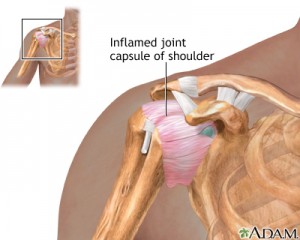What is Frozen Shoulder?
It can be a strange thing to suddenly have shoulder pain without injury or reason for the pain. This pain will stop you from moving your arms, which causes the shoulders to become stiff and to lose a range of motion. You may start asking others for help, reaching things that are above your head, and even reaching for things directly in front of you. Brushing your teeth and dressing becomes a daily issue. In time, the arm will have a loss of rotation, and everyday activities such as reaching over the head or even raising the arm above a certain point becomes impossible. Frozen shoulder usually affects only one arm, though some in some cases, the other arm developed frozen shoulder at another point in time.
What Causes Frozen Shoulder?
It is not clearly understood what is the underlying cause of frozen shoulder. However, we do understand the progression of the condition. Frozen shoulder starts with an inflammation of the joint capsule of the shoulder joint. This shoulder joint holds the bones of the shoulder to each other with ligaments. The inflammation of the ligaments of the joint capsule causes the shoulder pain and over time, prevents a range of motion in the shoulder joint. The shoulder becomes “frozen” and unable to move.
Factors of Frozen Shoulder
- shoulder injury or surgery
- often in people 40 – 70 years old
- more often in postmenopausal women
- often in people with chronic diseases
- cervical disk (neck) subluxations or disease
- hyperthyroidism
- diabetes
- open heart surgery
Medical doctors will examine the frozen shoulder and order x-rays and/or MRIs to see if arthritis or other issues are a factor. If the diagnosis is frozen shoulder, the MD will suggest nonsteroidal anti-inflammatory medications (NSAIDs), daily intense physical therapy, and steroid injections. Surgery may be recommended if symptoms do not improve.
There are only a handful of chiropractors that specialize in treating frozen shoulder. These chiropractors will do an examination of the shoulder and the spine determine if the diagnosis is frozen shoulder. The range of motion will be tested laterally raising the arm to the side and raising the arm forward in the sagittal plane. Raising the arm to the back is not as restricted or as noticeable for the patient. After the examination, the chiropractor may adjust the spine and then the shoulder.
Some of the frozen shoulder adjustments may be painful if no anesthesia is used, even though chiropractic adjustments in general are not painful. However, adjustments for frozen shoulder will give the greatest amount of correction in the first visit. A short and sharp increase in pain may be felt directly after the adjustment, but the pain will calm down in a few minutes. After the pain subsides, the chiropractor will again test the range of motion, which can improve as much as 50% or more after the first visit with certain chiropractors. Typically, the pain will be less severe than before the adjustment. The chiropractor will then recommended some exercises, which will also improve the effectiveness of the chiropractic adjustments.
Every subsequent adjustment for the frozen shoulder will show improvements in the range of motion, but these improvements will be less than after the first adjustment. Patients feel the greatest discomfort and pain when their range of motion is at 90 degrees or less. When the range of motion is greater than at 90 degrees, the pain is typically less.
Getting early treatment for frozen shoulder is the best way to prevent stiffness leading to a more severe case of frozen shoulder.
Chiropractors that can improve frozen shoulders offer patients a natural way to help the body heal itself. Patients have said they can now brush their teeth and shampoo their hair again. Patients regain the gift of motion in their shoulders that many of us take for granted.
